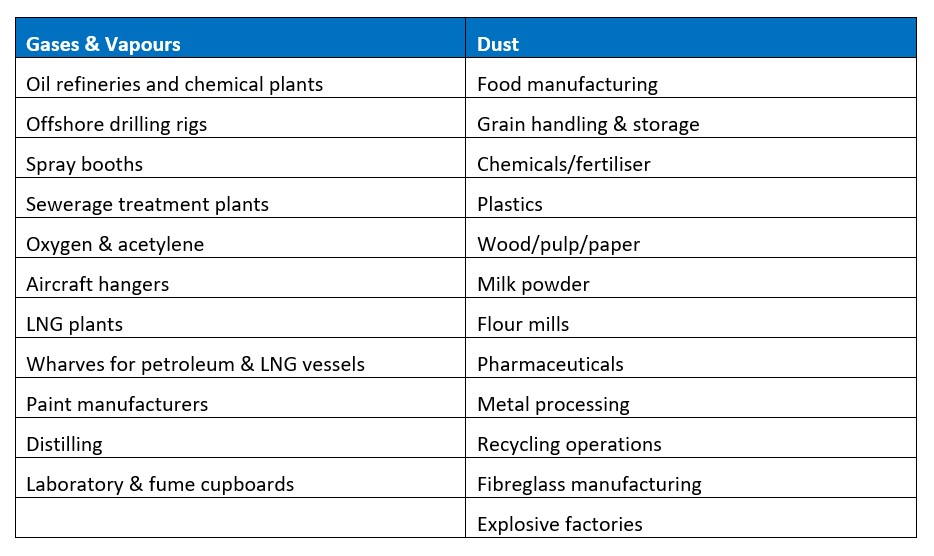The Roar Solutions Statements
Wiki Article
The smart Trick of Roar Solutions That Nobody is Talking About
Table of ContentsSome Known Details About Roar Solutions The Ultimate Guide To Roar SolutionsExamine This Report about Roar Solutions
In order to secure setups from a prospective surge a technique of evaluating and classifying a potentially dangerous area is required. The purpose of this is to make certain the proper option and setup of equipment to inevitably stop an explosion and to ensure safety of life.
(https://sitereport.netcraft.com/?url=https://training.roarsolution.com.au)
No tools needs to be installed where the surface area temperature of the equipment is higher than the ignition temperature of the offered risk. Below are some typical dirt unsafe and their minimal ignition temperature level. Coal Dust 380C 225C Polythene 420C (melts) Methyl Cellulose 420C 320C Starch 460C 435C Flour 490C 340C Sugar 490C 460C Grain Dirt 510C 300C Phenolic Resin 530C > 450C Aluminium 590C > 450C PVC 700C > 450C Residue 810C 570C The chance of the threat being present in a focus high sufficient to create an ignition will differ from location to place.
In order to classify this threat an installment is split right into areas of threat relying on the quantity of time the hazardous is present. These areas are described as Areas. For gases and vapours and dirts and fibres there are three areas. Zone 0 Zone 20 An unsafe ambience is extremely most likely to be existing and might be existing for long periods of time (> 1000 hours annually) or perhaps continually Area 1 Zone 21 An unsafe atmosphere is feasible but unlikely to be existing for lengthy periods of time (> 10 450 C [842 F] A category of T6 suggests the minimum ignition temperature is > 85 C [185 F] Harmful location electric tools perhaps made for use in higher ambient temperatures. This would showed on the score plate e.g. EExe II C T3 Ta + 60C( This means at 60C ambient T3 will certainly not be gone beyond) T1 T1, T2, T3, T4, T5, T6 T2 T2, T3, T4, T5, T6 T3 T3, T4, T5, T6 T4 T4, T5, T6 T5 T5, T6 T6 T6 A T Course score of T1 indicates the maximum surface temperature level produced by the instrument at 40 C is 450 C. Assuming the associated T Course and Temperature level rating for the tools are ideal for the location, you can always make use of an instrument with a much more strict Division rating than required for the location. There isn't a clear response to this inquiry. It really does depend upon the kind of devices and what repair work need to be performed. Devices with particular test treatments that can't be performed in the area in order to achieve/maintain 3rd party ranking. Should return to the factory if it is before the equipment's service. Area Fixing By Authorised Worker: Complex testing might not be needed nonetheless certain procedures might require to be followed in order for the tools to maintain its 3rd party ranking. Authorised employees need to be employed to carry out the work correctly Repair service should be a like for like substitute. New component should be thought about as a direct replacement needing no unique screening of the equipment after the repair work is full. Each tool with a dangerous ranking should be evaluated independently. These are described at a high level listed below, however, for more comprehensive details, please refer straight to the standards.
4 Easy Facts About Roar Solutions Described
The equipment register is an extensive database of devices documents that consists of a minimum collection of areas to determine each product's place, technical specifications, Ex lover category, age, and ecological data. This information is vital for monitoring and taking care of the equipment efficiently within harmful locations. In contrast, for regular or RBI sampling evaluations, the quality will certainly be a mix of In-depth and Close examinations. The Get More Info proportion of Detailed to Close inspections will certainly be figured out by the Equipment Risk, which is assessed based on ignition threat (the probability of a resource of ignition versus the possibility of a flammable environment )and the hazardous location category( Zone 0, 1, or 2). This variant will additionally influence the resourcing requirements for work prep work. Once Whole lots are defined, you can establish tasting plans based on the sample dimension of each Lot, which describes the variety of arbitrary equipment things to be inspected. To determine the required example dimension, two aspects require to be evaluated: the size of the Whole lot and the group of inspection, which indicates the level of effort that must be applied( reduced, normal, or raised )to the assessment of the Whole lot. By integrating the group of evaluation with the Whole lot size, you can after that establish the ideal being rejected requirements for a sample, indicating the allowable number of faulty items located within that sample. For more information on this procedure, please describe the Power Institute Standards. The IEC 60079 conventional advises that the maximum period in between inspections need to not exceed 3 years. EEHA inspections will additionally be conducted outside of RBI projects as part of scheduled maintenance and equipment overhauls or repair work. These assessments can be attributed toward the RBI example sizes within the impacted Whole lots. EEHA inspections are carried out to determine mistakes in electric equipment. A weighted racking up system is crucial, as a single tool might have numerous faults, each with varying degrees of ignition danger. If the mixed rating of both examinations is much less than two times the mistake rating, the Whole lot is considered appropriate. If the Whole lot is still thought about unacceptable, it needs to go through a full examination or reason, which might cause stricter examination methods. Accepted Whole lot: The reasons of any kind of mistakes are determined. If a common failure mode is discovered, additional devices might require maintenance. Faults are classified by severity( Safety, Stability, Home cleaning ), making certain that immediate problems are evaluated and dealt with immediately to minimize any kind of impact on safety or operations. The EEHA database must track and tape the lifecycle of faults in addition to the rehabilitative actions taken. Carrying out a robust Risk-Based Inspection( RBI )method is important for guaranteeing conformity and safety and security in taking care of Electrical Tools in Hazardous Locations( EEHA) (Roar Solutions). Automated Fault Rating and Lifecycle Management: Effortlessly handle faults and track their lifecycle to enhance evaluation accuracy. The introduction of this assistance for risk-based evaluation further enhances Inspectivity's setting as a best-in-class service for governing conformity, along with for any type of asset-centric examination use situation. If you are interested in finding out more, we welcome you to request a demonstration and find how our remedy can transform your EEHA management procedures.
The Basic Principles Of Roar Solutions

In regards to eruptive risk, an unsafe location is a setting in which an eruptive environment is existing (or may be anticipated to be present) in amounts that need unique preventative measures for the building and construction, setup and use devices. eeha certificate. In this post we explore the obstacles dealt with in the office, the danger control actions, and the called for expertises to work safely
These substances can, in certain problems, develop explosive environments and these can have major and unfortunate effects. Many of us are familiar with the fire triangular get rid of any type of one of the 3 components and the fire can not take place, however what does this mean in the context of hazardous areas?
In many instances, we can do little about the degrees of oxygen in the air, yet we can have significant influence on sources of ignition, for instance electrical devices. Unsafe areas are recorded on the unsafe location classification drawing and are recognized on-site by the triangular "EX LOVER" indicator. Right here, amongst other vital information, areas are split right into three types relying on the threat, the likelihood and period that an explosive environment will certainly exist; Zone 0 or 20 is deemed the most dangerous and Zone 2 or 22 is considered the least.
Report this wiki page